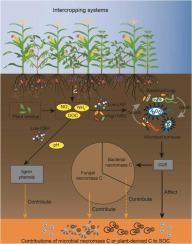Agriculture, Ecosystems & Environment ( IF 6.0 ) Pub Date : 2024-01-13 , DOI: 10.1016/j.agee.2023.108880
Qirui Zhu , Ziyu Yang , Yuping Zhang , Yizhe Wang , Jiangchi Fei , Xiangmin Rong , Jianwei Peng , Xiaomeng Wei , Gongwen Luo

|
Intercropping can increase soil carbon (C) sequestration and utilization by planting a variety of plants on a same land. However, the main plant and microbial-driven pathways leading to the increased C sequestration in intercropping soils are rarely studied. Therefore, it is important to reveal the distinct contributions of plant- and microbe-derived C to soil organic C (SOC) for understanding the regulation of intercropping in global C storage. Herein, two widely accepted sets of bio-markers, namely, amino sugars and lignin phenols, were employed to compare the distribution of plant- and microbe-derived C as well as their contributions to SOC in maize monoculture and intercropping systems, based on a field experiment established in 2013; meanwhile, the associations of soil physicochemical properties and microbial physiological traits with plant- and microbe-derived residues were disclosed via correlation and model analysis. Compared with the monoculture, maize intercropping significantly increased soil amino sugar and microbial necromass C contents as well as their contributions to SOC in maize mature stage; maize inter-planted with gingelly or soybean significantly increased these variables in the elongation stage; meanwhile, maize inter-planted with gingelly significantly increased soil lignin phenol content and its contribution to SOC in the mature stage. In all treatments and growth stages, microbial necromass C contributed more to SOC than lignin phenols, and fungal necromass C contributed more to SOC than bacterial necromass. The contribution of microbial necromass C to SOC was mainly influenced by amino sugar content, microbial C use efficiency, dissolved organic C content, and microbial biomass C content. The contribution of plant-derived C to SOC was mainly influenced by lignin phenol content, pH, and NH4+-N content. These results demonstrate the distinct regulations of maize intercropping on plant- and microbe-derived C to soil C pool by influencing soil physicochemical properties and microbial physiological traits, and meanwhile, highlight the potential of intercropping in global C storage.
中文翻译:

间作通过影响土壤理化和微生物生理特性来调节植物和微生物来源的碳积累
间作可以通过在同一块土地上种植多种植物来增加土壤碳 (C) 固存和利用。然而,导致间作土壤固碳增加的主要植物和微生物驱动途径却很少被研究。因此,揭示植物和微生物来源的碳对土壤有机碳(SOC)的独特贡献对于理解全球碳储存中间作的调节非常重要。在此,采用两组广泛接受的生物标记物,即氨基糖和木质素酚,基于2013年建立现场实验;同时,通过相关性和模型分析揭示了土壤理化性质和微生物生理性状与植物和微生物残留物的关联。与单作相比,玉米间作显着提高了玉米成熟期土壤氨基糖和微生物坏死物C含量及其对SOC的贡献;与玉米或大豆套种的玉米在伸长期显着增加了这些变量;同时,套种玉米显着提高了成熟期土壤木质素酚含量及其对SOC的贡献。在所有处理和生长阶段,微生物坏死物 C 对 SOC 的贡献大于木质素酚,真菌坏死物 C 对 SOC 的贡献大于细菌坏死物。微生物坏死物C对SOC的贡献主要受氨基糖含量、微生物C利用效率、溶解有机C含量和微生物生物量C含量的影响。植物源C对SOC的贡献主要受木质素酚含量、pH和NH 4 + -N含量的影响。这些结果证明了玉米间作通过影响土壤理化性质和微生物生理性状对植物和微生物来源的碳对土壤碳库的独特调节,同时凸显了间作在全球碳储存中的潜力。































 京公网安备 11010802027423号
京公网安备 11010802027423号